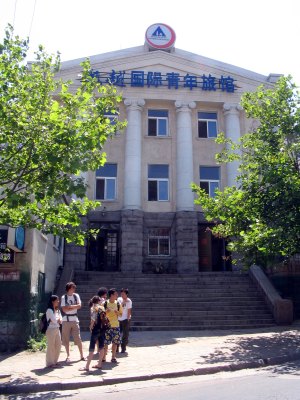Before coming to China, I had so many theories (and misconceptions) of what Beijing would be like. As a child I had come with my uncle and cousin for a tour of the Summer Palace, The Forbidden City, and various other notable spots I'm sure. I remember the city being cold, dirty, and sterile. Well, the first two still apply, but having ditched the hotel rooms and tour bus I uncovered a city teeming with history and nationalism yet relentlessly modernizing. I believe that it is possible to modernize without westernize and that China is developing its own renaissance so to speak. The first signs can be seen in contemporary art and architecture. Thanks to a Beijing buddy I was able to get a more intimate slice of the city. This post will be about art and night life from a more localized perspective I hope.
The 798 Art District used to house many industrial factories before it was transformed in to a neighborhood of galleries, artisan shops, and restaurants.
A European bust of a man is covered with a Chinese, ceramic, floral pattern.
A cartoonish stainless steel sculpture by Xia Hang entitled
It's Not Far features a funny little creature with propellers on his back.
A stainless steel version of historical literary icon, Lao Zi by artist Zheng Lu is perforated using passages from his own works. Lao Zi therefore becomes transparent yet still heavy.
String art decorates a tree outside a clothing shop.
An Art Noveau style defines an entrance to a Spanish gallery...
while a more simple, rustic approach transforms a log in to steps for a shop.
Travel a little south to the Sanlitun neighborhood and you will find an awesome example of architecture as art.
Opposite House by Japanese architect, Kengo Kuma is probably one of the most beautiful (interior) places I have ever seen in my life. This may be in part due to the
uber expensive 98-room hotel also functioning as a rotating gallery space for artists. Not to mention, the staff materialize out of thin air due to cleverly concealed doors and work stations. I am beyond words, only that the Japanese really do aim for perfection.
Sanlitun, is also a popular night spot where a mixture of established clubs and dive bars converge in on each other.
My Beijing buddy is Sohith, a transplanted New York designer in Beijing for the architect's playground that has become this city. Although China holds great opportunity to build for the architecture industry, competition is fierce and the hours are way longer compared to the US. How do you balance this? You go out even more to equalize work time and play time.
It's pretty easy to get in to places around here; there were no annoying lines, pretentious bouncers, or closing times it seems. Below is a roof top bar at dawn.
Maybe I should have tried something more authentic for street food, but by then again, I already had my fill of Chinese and was really craving something more Western. Thank goodness they didn't screw it up.
The whole area of Sanlitun is only several blocks in total of alleys and streets but already a paradox in itself of class and crass.
















































